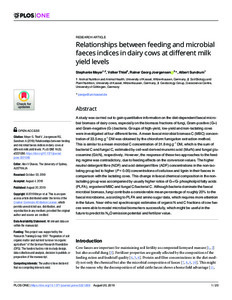| dc.date.accessioned | 2019-09-06T09:53:38Z | |
| dc.date.available | 2019-09-06T09:53:38Z | |
| dc.date.issued | 2019-08-20 | |
| dc.identifier | doi:10.17170/kobra-20190903648 | |
| dc.identifier.uri | http://hdl.handle.net/123456789/11298 | |
| dc.description.sponsorship | Gefördert durch den Publikationsfonds der Universität Kassel | ger |
| dc.language.iso | eng | eng |
| dc.rights | Urheberrechtlich geschützt | |
| dc.rights.uri | https://rightsstatements.org/page/InC/1.0/ | |
| dc.subject.ddc | 630 | |
| dc.title | Relationships between feeding and microbial faeces indices in dairy cows at different milk yield levels | eng |
| dc.type | Aufsatz | |
| dcterms.abstract | A study was carried out to gain quantitative information on the diet-dependent faecal microbial biomass of dairy cows, especially on the biomass fractions of fungi, Gram-positive (G+) and Gram-negative (G-) bacteria. Groups of high-yield, low-yield and non-lactating cows were investigated at four different farms. A mean faecal microbial biomass C (MBC) concentration of 33.5 mg g-1 DM was obtained by the chloroform fumigation extraction method. This is similar to a mean microbial C concentration of 31.8 mg g-1 DM, which is the sum of bacterial C and fungal C, estimated by cell-wall derived muramic acid (MurN) and fungal glucosamine (GlcN), respectively. However, the response of these two approaches to the feeding regime was contradictory, due to feeding effects on the conversion values. The higher neutral detergent fibre (NDF) and acid detergent fibre (ADF) concentrations in the non-lactating group led to higher (P < 0.05) concentrations of cellulose and lignin in their faeces in comparison with the lactating cows. This change in faecal chemical composition in the non-lactating group was accompanied by usually higher ratios of G+/G- phospholipid fatty acids (PLFA), ergosterol/MBC and fungal C/bacterial C. Although bacteria dominate the faecal microbial biomass, fungi contribute a considerable mean percentage of roughly 20% to the faecal microbiome, according to PLFA and amino sugar data, which requires more attention in the future. Near-infra red spectroscopic estimates of organic N and C fractions of cow faeces were able to model microbial biomarkers successfully, which might be useful in the future to predict its N2O emission potential and fertilizer value. | eng |
| dcterms.accessRights | open access | |
| dcterms.creator | Meyer, Stephanie | |
| dcterms.creator | Thiel, Volker | |
| dcterms.creator | Jörgensen, Rainer Georg | |
| dcterms.creator | Sundrum, Albert | |
| dc.relation.doi | doi:10.1371/journal.pone.0221266 | |
| dc.type.version | publishedVersion | |
| dcterms.source.identifier | ISSN 1932-6203 | |
| dcterms.source.issue | 8 | |
| dcterms.source.journal | PLoS ONE | eng |
| dcterms.source.pageinfo | e0221266 | |
| dcterms.source.volume | Vol. 14 | |

